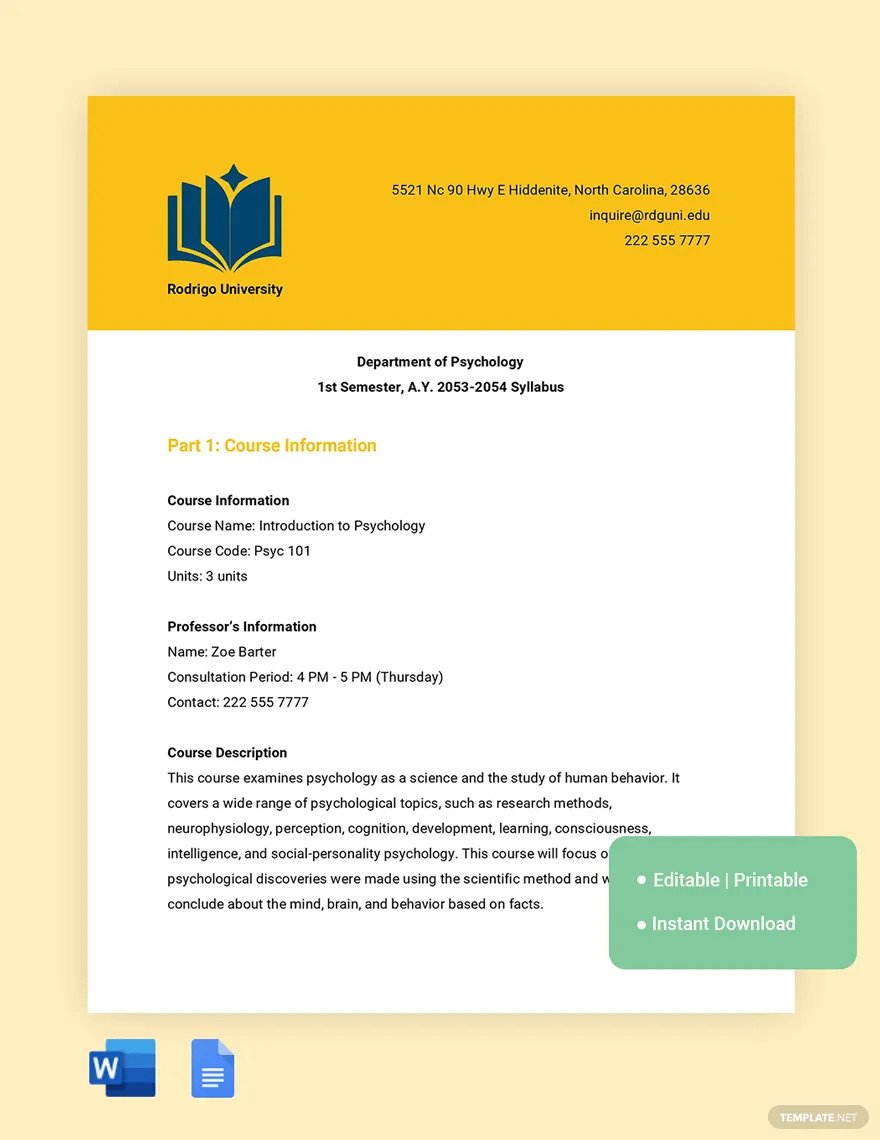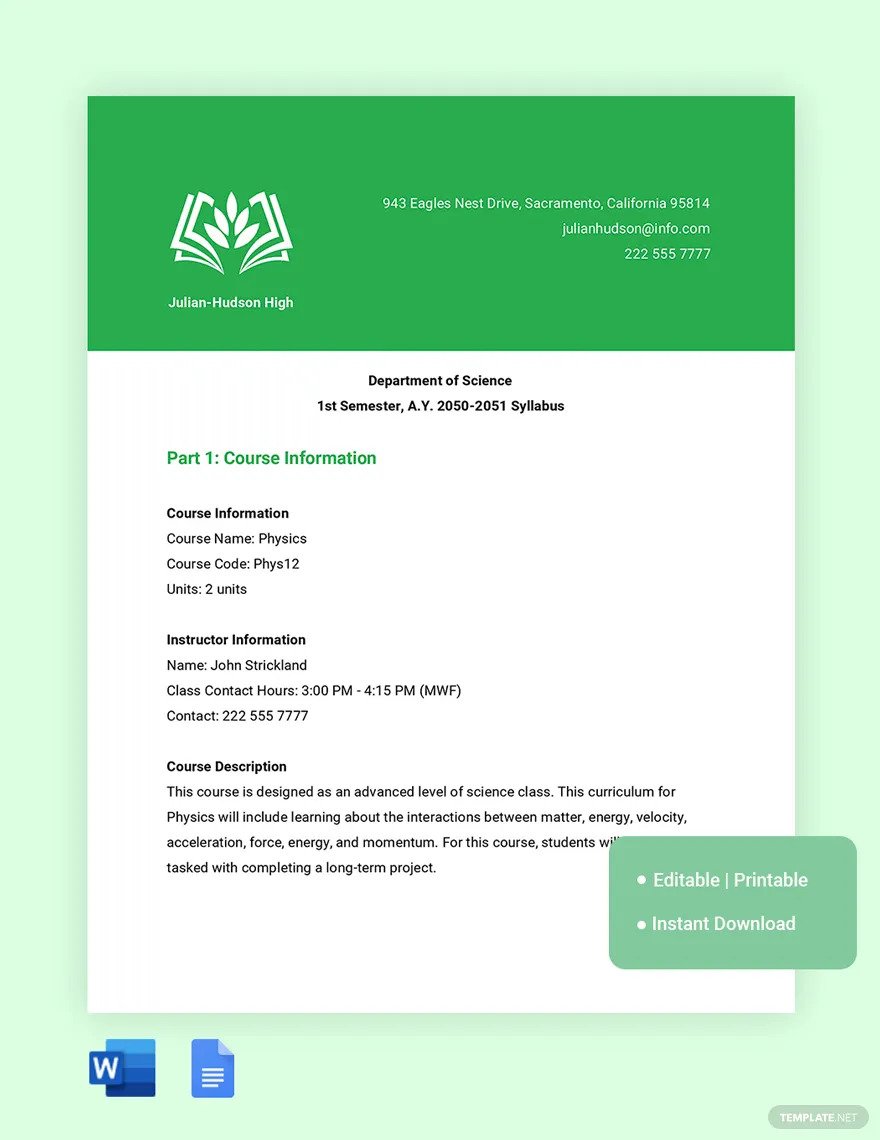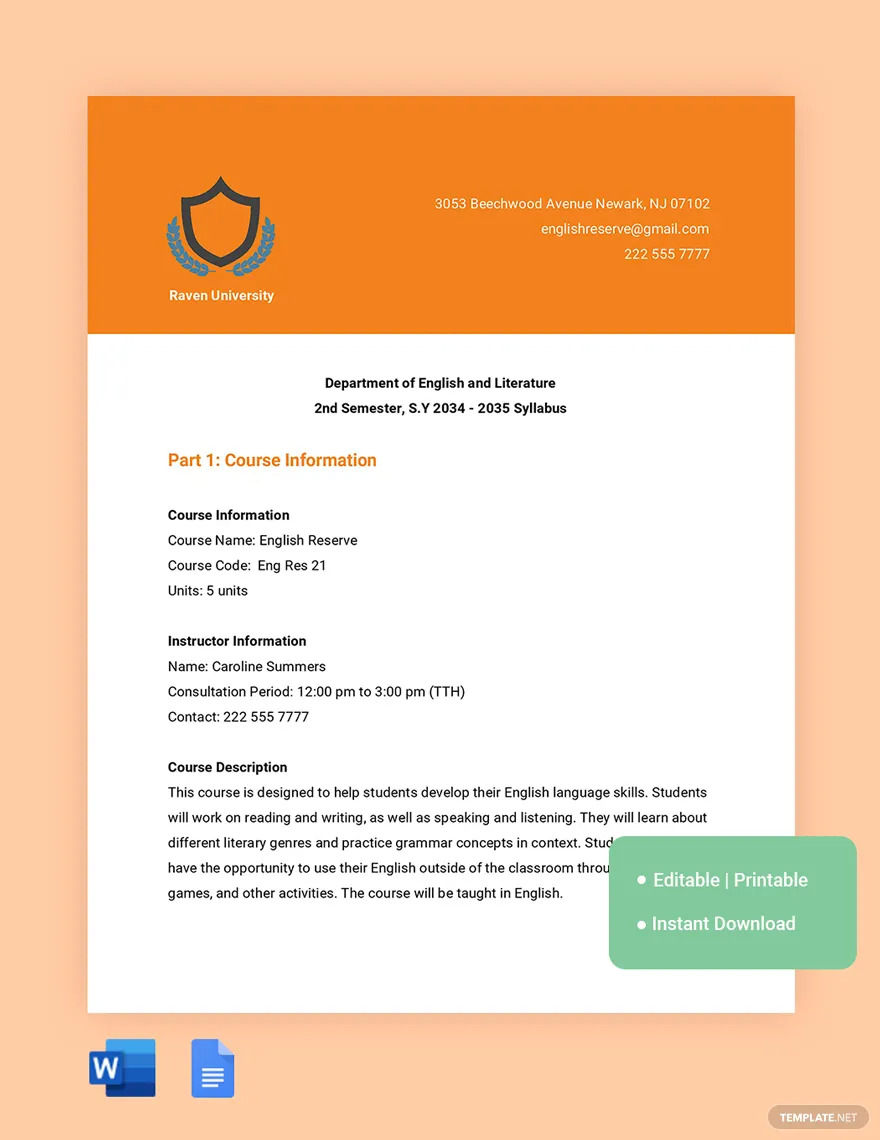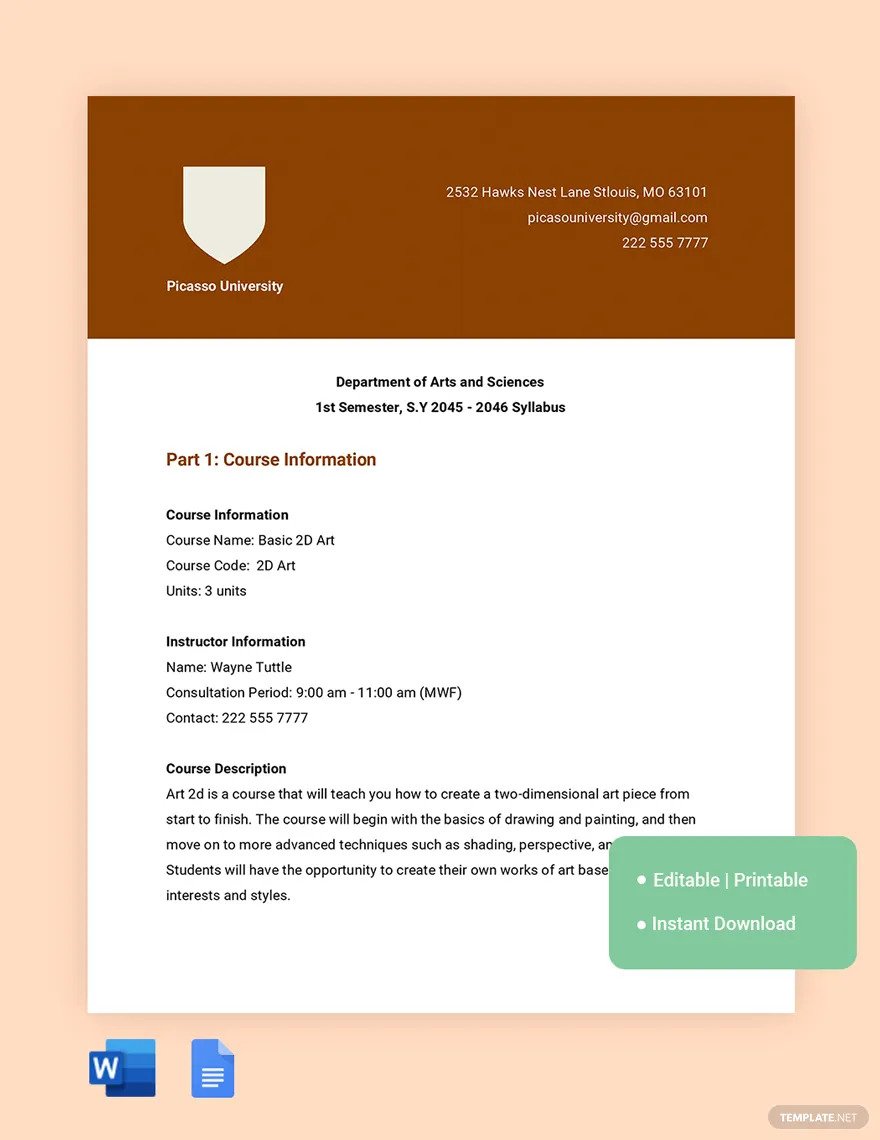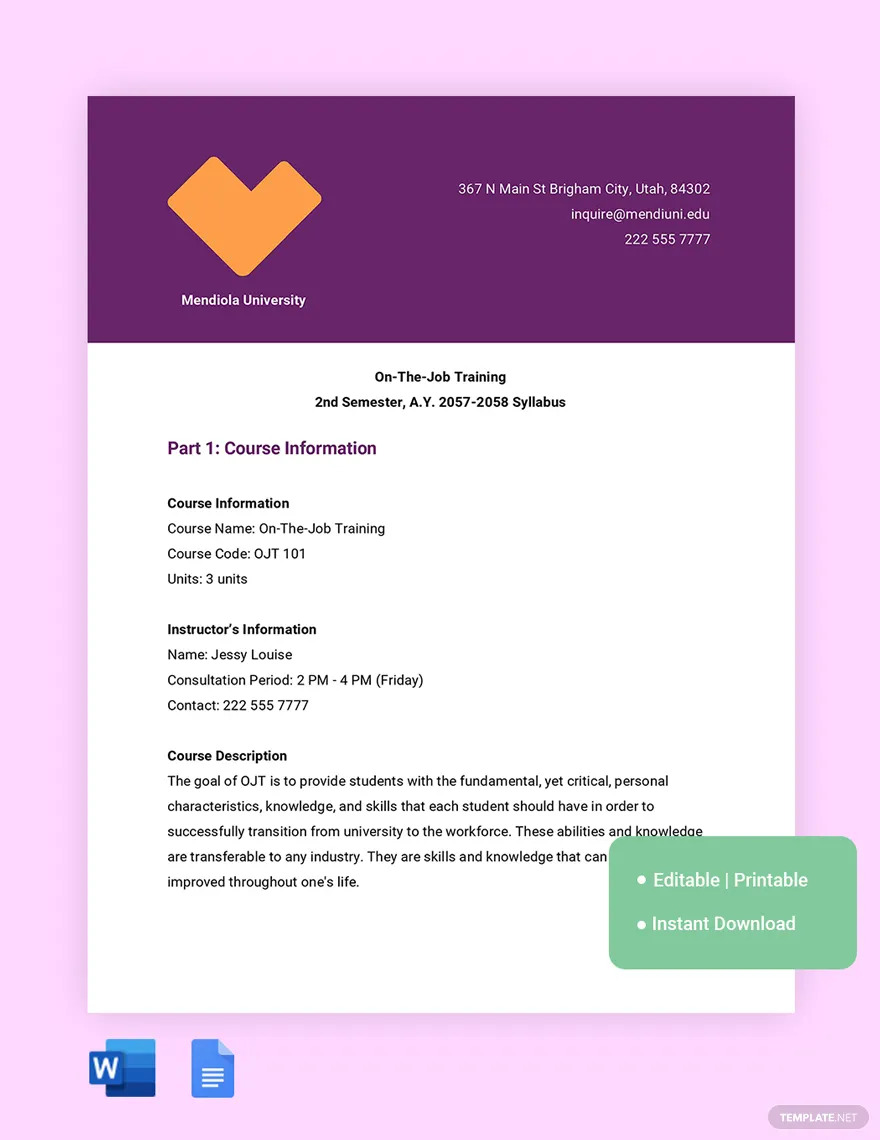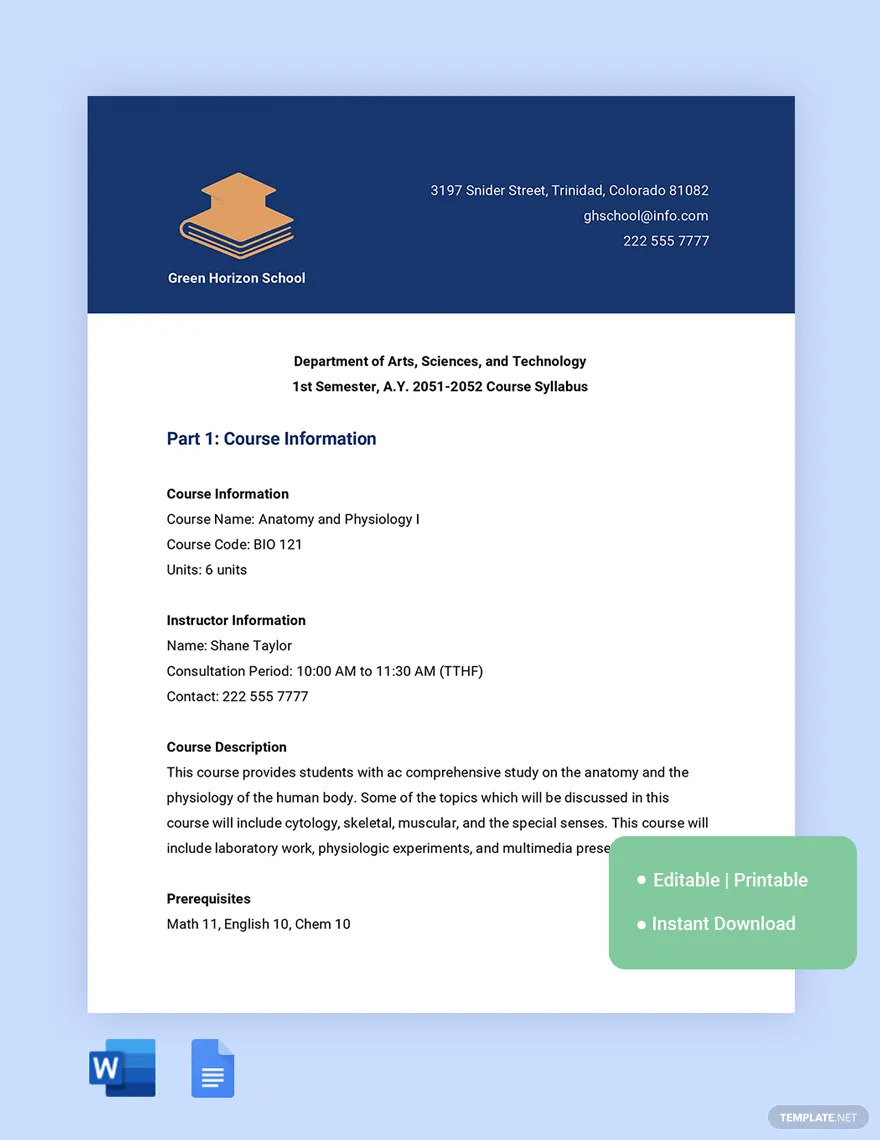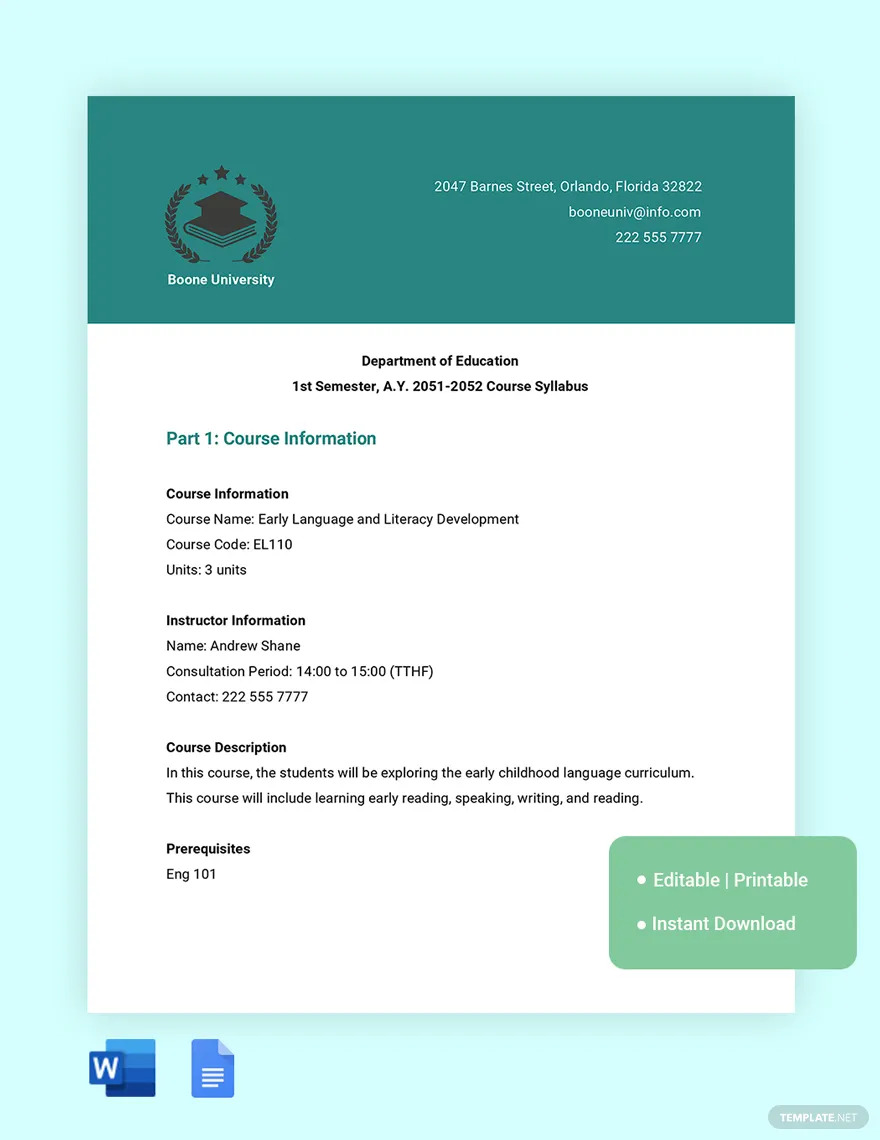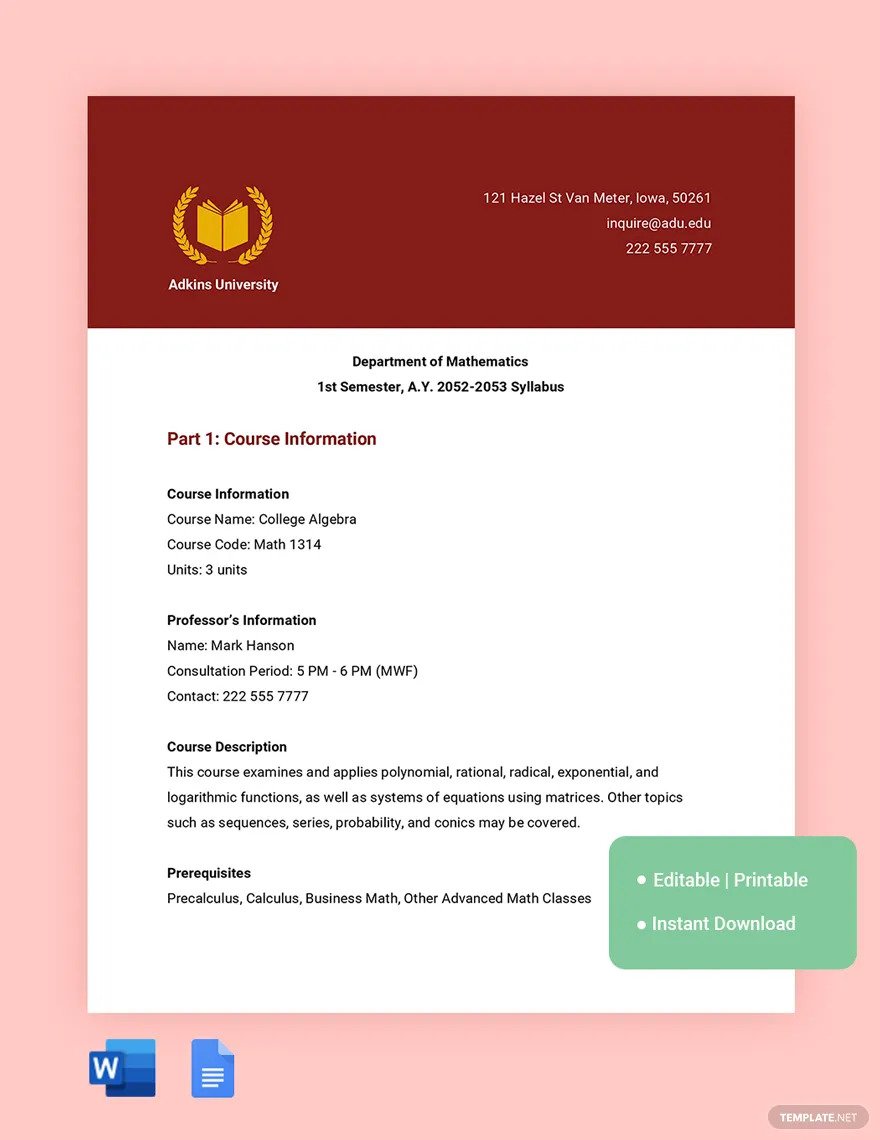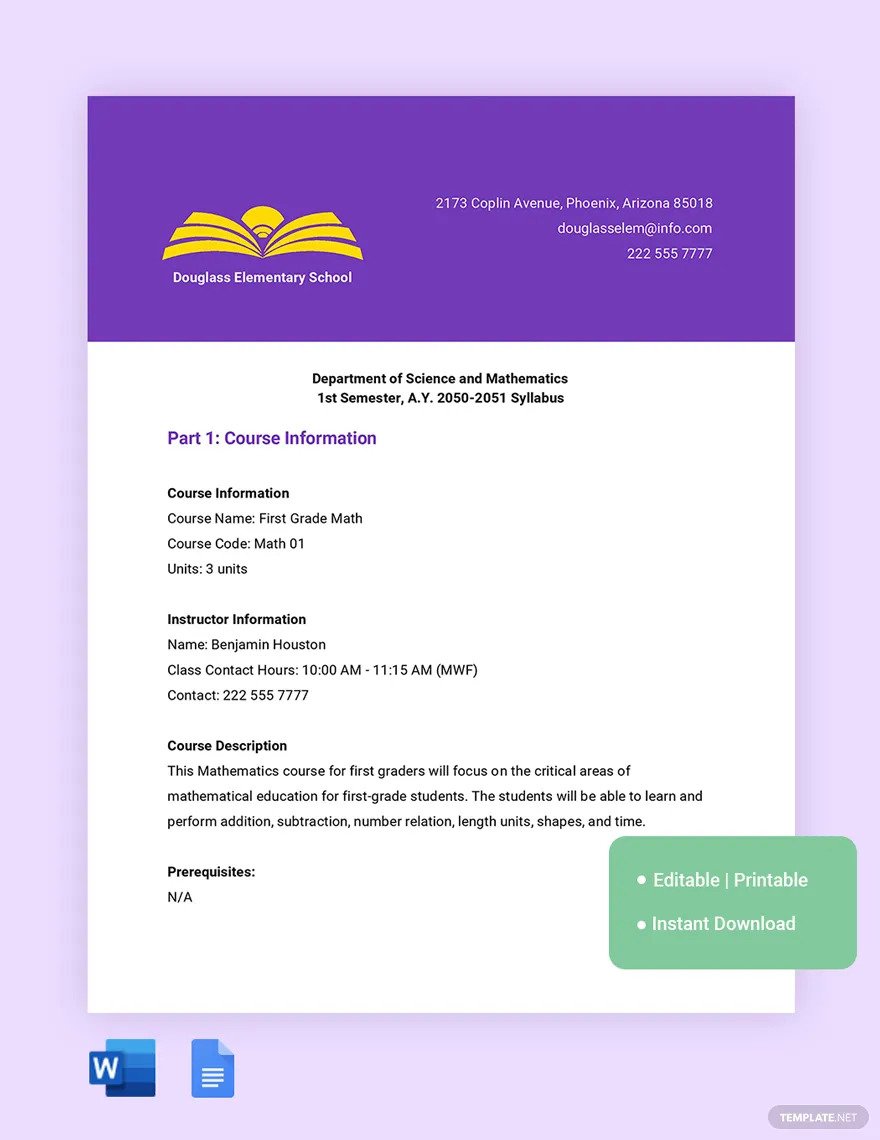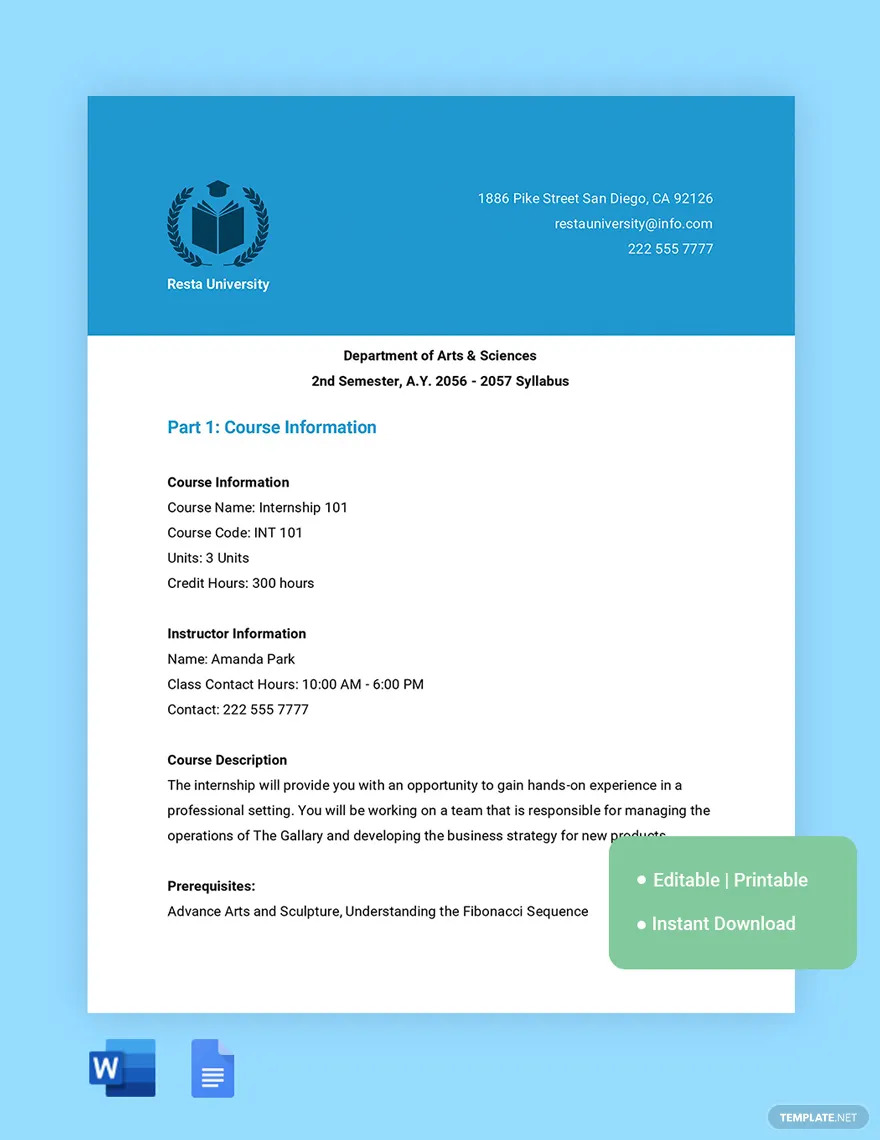Syllabus
A syllabus is a helpful tool for both students and teachers, especially when keeping track of their course topics, classroom activities, and other academic requirements. A syllabus templates is handy and practical, and it helps promote an organized and systematic classroom experience for everyone.

Download the Free Syllabus Article In PDF!
File Format:Syllabus Definition and Meaning
A syllabus is a formal document that outlines the specific details of a particular academic course or subject.
It is typically given at the beginning of a course or within the first few weeks of class. A syllabus is applied or used for a specific period, such as an academic semester or grading period.
What Is a Syllabus?
A syllabus is a classroom document issued by the instructor to the students. It is an informative guide that provides details about a particular course. A syllabus helps manage the students’ course expectations as well. It is typically the task of teachers, professors, and instructors to come up with the syllabus for distribution to students.
10 Types of Syllabus
College Syllabus
College is an important educational milestone for any student. With multiple classes and other activities, a detailed college syllabus can help undergrads juggle their academics and manage both their time and expectations. The template below is an example of a Psychology course syllabus that includes a brief course description and professor information.
High School Syllabus
Students are required to take all kinds of basic subjects in high school. For them to better manage their academic needs and study time, a high school syllabus is a helpful and practical tool. Like in the example below, you can also include a departmental or school logo in your letterhead.
Course Syllabus
There are dozens of academic courses offered in schools and universities. From Geography, Biology, to History, a course syllabus is a basic guide that helps students manage course expectations. Because it is an informative document, it is necessary to include vital contact details- whether it be a school address or a working email address.
Art Syllabus
The Arts and Humanities make up an important aspect of education. Whether it’s creative writing, theater arts, information design, or art management, any subject requires an art syllabus that outlines the various course topics and requirements. The document itself does not need to be long, a page or two should suffice.
Training Syllabus
Any successful individual does not become an expert in their field overnight. Dedicated and consistent training is needed to master a subject or skill. A training syllabus will provide basic course information and a short description of the course as well.
Science Syllabus
Science is a core subject that’s taught from nursery all the way to graduate school. Whether it’s scientific research, natural sciences, or medical technology, a science syllabus shouldn’t only be course-specific, it must also be grade-level appropriate. Since a lot of science courses require several prerequisites, it’s important to include these in the syllabus as well, as seen in the example below.
Education Syllabus
Education is a basic right in a lot of countries. Whether it’s a public or private school, an education syllabus is one of the most basic documents that students need at the start of any course. It is the teacher or professor’s responsibility to provide each student with their own copy.
Math Syllabus
For students, Math is probably one of the most unpopular subjects. But even if a lot of people find mathematical concepts challenging, it is still a core school subject. Having a math syllabus can help the student better prepare and plan for upcoming topics.
Elementary Syllabus
Elementary school is also referred to as grade school or primary school. Elementary school is a key part of a young student’s formative years. The example below is an elementary syllabus complete with the teacher’s contact information.
Internship Syllabus
An internship or apprenticeship is a learning approach where the student gains actual work experience. It’s sometimes referred to as on-the-job training. An internship syllabus helps the intern navigate what is expected of them at work.
Syllabus Uses, Purpose, Importance
A syllabus is an important document for both students and teachers. The following describes just some of a syllabus’s key uses, purposes, and importance.
Management
A syllabus is essentially a management tool. It helps manage a student’s expectations of a course and its different requirements and topics for a given period. As for the teacher or instructor, it also helps them manage lessons and course topics.
Reminder
A syllabus serves as a potent reminder throughout the semester or grading period. Since it gives the student a preview of what’s to come, it enables them to plan in advance and adequately prepare. Students have no reason not to prepare if they are given an overview of the course.
Guide
A syllabus, more than anything, is a guide for both students and teachers. It serves as a point of reference wherein the course topics are arranged in order and the course requirements are listed accordingly. Students and teachers alike can refer to this guide at any point during the semester or grading period.
Contact Information
A syllabus also contains the course instructor’s contact details. In case students need to reach the teacher or professor outside of the classroom, they are informed of the proper channels on how to do so. A working contact number, email address, and the teacher’s contact hours ought to be indicated in the syllabus.
Blueprint
Most syllabi have similar structures and formats. One syllabus can serve as a basic blueprint for other types of syllabi. This way, you don’t need to start from scratch every time you need to create a syllabus. With the format in place, you only need to change and modify the syllabus’ content.
What’s in a Syllabus? Parts?
Course Title
A syllabus should always contain the course title and basic details about the course. You can include a brief description or a couple of sentences describing the course.
Learning Objectives
Identify the learning objectives or purpose of the course. You can list them down numerically or in bullet points to make it more organized.
Course Topics
An essential part of a syllabus is the list of topics to be covered. You may also include the required reading material or resources for every topic.
Timeline
The course topics should be arranged in order. The topics usually have a corresponding timeline based on the teaching schedule.
Course Requirements
A syllabus must also indicate the different course requirements (e.g., exams, thesis, etc.) to help the student manage their expectations and time. Make sure to include criteria or grading systems for the semester, trimester, or quarter.
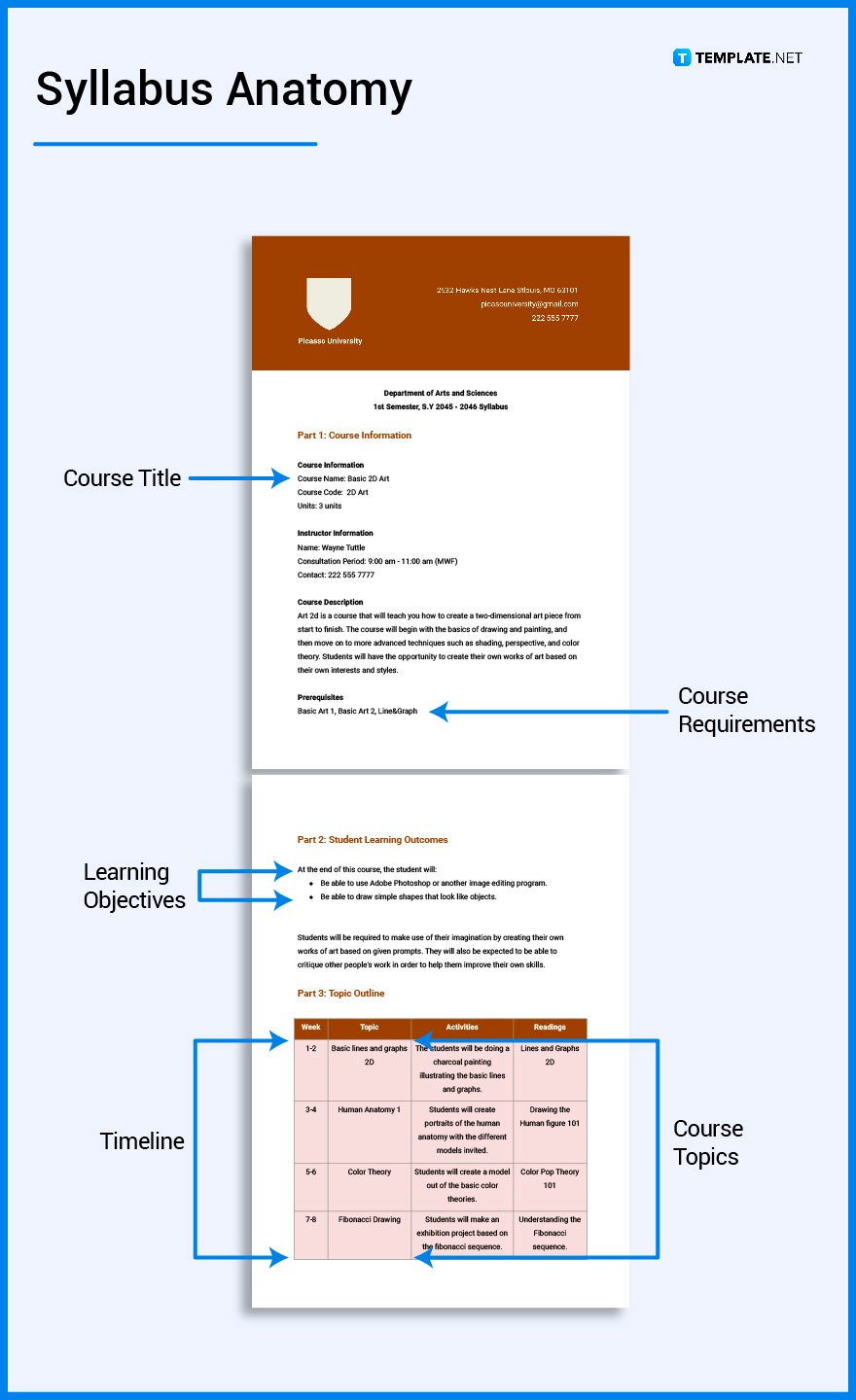
How to Design a Syllabus
1. Choose a Syllabus Size
2. Decide the purpose of the syllabus
3. Select a Syllabus Template
4. Edit the course title and description
5. Enumerate the course topics and schedule
6. Include the instructor’s contact information and other basic reminders

Syllabus vs. Curriculum
A syllabus is a document that outlines the various topics and requirements of a specific academic subject or course.
A curriculum is a comprehensive academic outline or instructional plan. It is more broad and general compared to a syllabus.
What’s the Difference Between a Syllabus, Lesson Plan, and Unit Plan?
A syllabus is a guide that provides a detailed overview of course topics for a specific subject. It contains relevant information such as the course description and the teacher’s contact details.
A lesson plan is a comprehensive plan created by teachers to address the learning objectives and needs of students.
A unit plan is much broader than a lesson plan. It consists of a series of plans for an academic unit or department.
Syllabus Sizes
A syllabus normally comes in a standard format. However, it also comes in three different sizes depending on the length of the content. It’s recommended that you know these syllabus sizes before proceeding to write one.
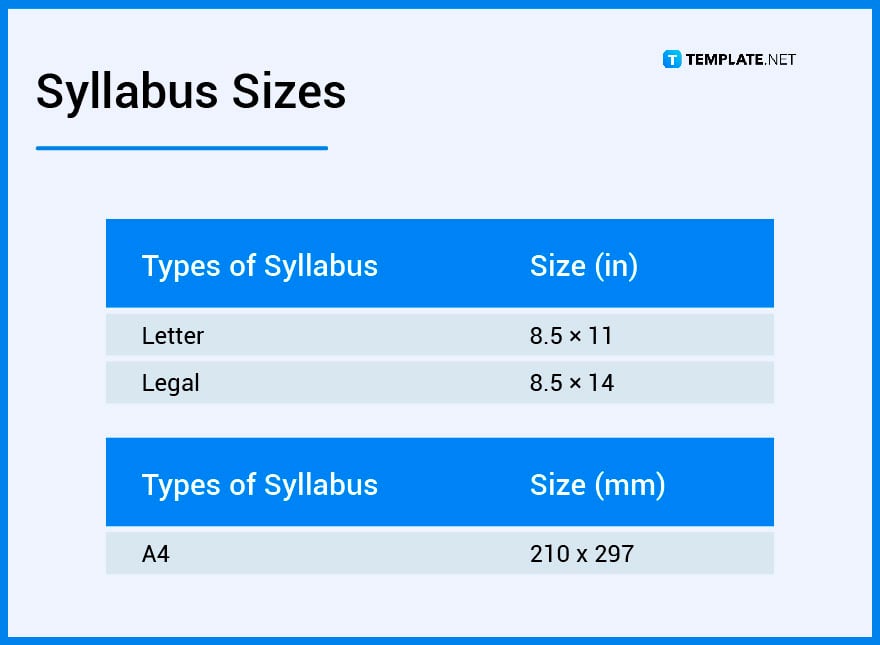
Syllabus Ideas & Examples
If you’re planning to design an educational syllabus of your own, referring to premade syllabus ideas and examples can help you get started.
- Syllabus Ideas and Examples
- Middle School Syllabus Ideas and Examples
- English Syllabus Ideas and Examples
- Training Syllabus Ideas and Examples
- Visual Syllabus Ideas and Examples
- Choir Syllabus Ideas and Examples
- Baking Syllabus Ideas and Examples
- Classroom Syllabus Ideas and Examples
- Language Arts Syllabus Ideas and Examples
- Spanish Syllabus Ideas and Examples
FAQs
What does a syllabus include?
A syllabus normally includes the course title, description, list of topics, course requirements, policies, and timeline.
What is a syllabus in education?
A syllabus is a document that outlines the various course topics of a certain subject within a given period.
How do you introduce a syllabus?
A syllabus can contain a brief introduction or description of the course, along with the course title.
What are the contents of a syllabus?
A syllabus contains the course description, list of course topics, requirements, and lesson timeline.
What is a syllabus in school?
It is a document provided to students that offers a detailed guide or outline about a particular academic course or class.
Why should students read the syllabus?
Students should refer to the syllabus so they can keep track of their lessons and course requirements.
What is syllabus structure?
Syllabus structure is the format wherein the different course topics are listed and arranged, usually in a particular order.
What is the best type of syllabus?
A functional syllabus or any syllabus that is detailed, specific, and organized.
What should a syllabus contain?
It should contain a list of topics to be covered and a summary of the different course requirements.
What is the process of syllabus designing?
Normally, the process of designing a syllabus is methodical and meticulous, however, the establishment of learning objectives and various consultations are key parts of the process.
What is a syllabus in simple words?
A syllabus is document that provides an informative overview of a course or academic subject.
What is a syllabus in learning?
A syllabus is simply an outline that helps or enables students’ learning in the classroom.
What is the purpose of a syllabus?
The purpose of a syllabus is to provide a helpful reference or guide for students when it comes to their academic subjects and courses.
How do you make a syllabus?
To make a syllabus, you can use any word processor application then type down the course title, description, requirements and list of topics.
What are the characteristics of a syllabus?
The ideal syllabus should be informative, clear, coherent and specific.
What are the four elements of a curriculum?
The four elements of a basic curriculum are objectives, contents, instruction and evaluation.
Why is it called a syllabus?
The word syllabus comes from the Latin word ‘syllabus’ which means ‘list’.
What is the difference between a curriculum and syllabus?
The main difference between a curriculum and syllabus is that the latter tends to focus on a particular subject while the former can contain several subjects or courses under an educational program.
